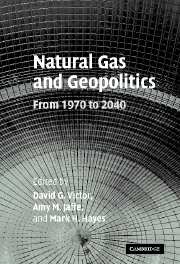Book contents
- Frontmatter
- Contents
- List of figures
- List of tables
- List of boxes
- List of contributors
- Foreword by James A. Baker, III
- Acknowledgments
- List of acronyms and abbreviations
- Part I Introduction and context
- Part II Historical case studies
- 2 Introduction to the historical case studies: research questions, methods and case selection
- 3 The Transmed and Maghreb projects: gas to Europe from North Africa
- 4 Liquefied natural gas from Indonesia: the Arun project
- 5 Bypassing Ukraine: exporting Russian gas to Poland and Germany
- 6 Natural gas pipelines in the Southern Cone
- 7 International gas trade in Central Asia: Turkmenistan, Iran, Russia, and Afghanistan
- 8 Liquefied natural gas from Qatar: the Qatargas project
- 9 Liquefied natural gas from Trinidad & Tobago: the Atlantic LNG project
- 10 Politics, markets, and the shift to gas: insights from the seven historical case studies
- Part III International gas trade economics
- Part IV Implications
- Appendix: Technical notes
- Index
- References
10 - Politics, markets, and the shift to gas: insights from the seven historical case studies
Published online by Cambridge University Press: 22 September 2009
- Frontmatter
- Contents
- List of figures
- List of tables
- List of boxes
- List of contributors
- Foreword by James A. Baker, III
- Acknowledgments
- List of acronyms and abbreviations
- Part I Introduction and context
- Part II Historical case studies
- 2 Introduction to the historical case studies: research questions, methods and case selection
- 3 The Transmed and Maghreb projects: gas to Europe from North Africa
- 4 Liquefied natural gas from Indonesia: the Arun project
- 5 Bypassing Ukraine: exporting Russian gas to Poland and Germany
- 6 Natural gas pipelines in the Southern Cone
- 7 International gas trade in Central Asia: Turkmenistan, Iran, Russia, and Afghanistan
- 8 Liquefied natural gas from Qatar: the Qatargas project
- 9 Liquefied natural gas from Trinidad & Tobago: the Atlantic LNG project
- 10 Politics, markets, and the shift to gas: insights from the seven historical case studies
- Part III International gas trade economics
- Part IV Implications
- Appendix: Technical notes
- Index
- References
Summary
Introduction
Most energy forecasts envision a shift to gas in the world energy system over the coming decades. To realize that vision will require tapping increasingly remote gas resources and shipping them to distant gas markets in other countries. Few analysts have explored the robustness of such projections in the real world where political and institutional factors exert strong influences on whether governments and private investors will be able to muster the capital for the long-distance pipelines and other infrastructure projects that are essential to a gas vision. Although gas has strong economic, technological, and environmental advantages over alternative energy sources, will the difficulty of securing contracts where legal institutions are weak – an attribute of nearly all the nations that are richest in gas resources – impede the outlook for global gas? Which gas resources and transportation infrastructures are likely to be developed? As gas infrastructures interconnect the world, what political consequences may follow? To help answer these questions, this study on the geopolitics of gas combines two tracks of research – one that employs seven historical case studies and another that rests on a quantitative model for projecting alternative futures for gas to 2040. Part II of this book has focused on the former – lessons from history – and this chapter examines the conclusions from the seven historical case studies presented in chapters 3–9.
- Type
- Chapter
- Information
- Natural Gas and GeopoliticsFrom 1970 to 2040, pp. 319 - 354Publisher: Cambridge University PressPrint publication year: 2006
References
- 7
- Cited by



